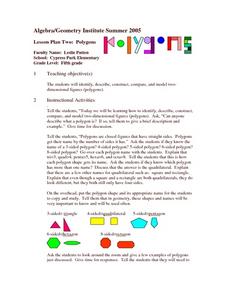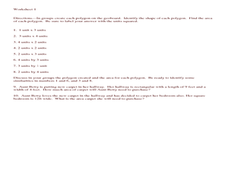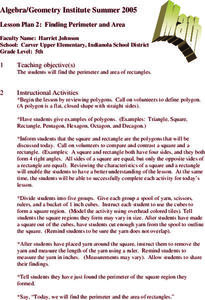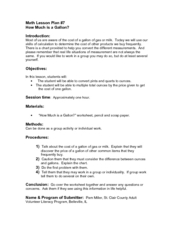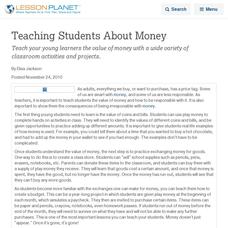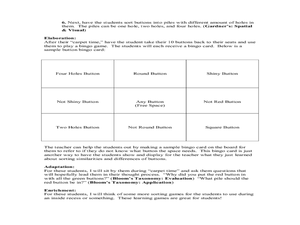Curated OER
Problem Solving
Fourth graders complete a worksheet identifying unnecessary information regarding 8 different math problems. In this problem solving lesson, 4th graders discuss the meaning of colors on a spotlight in order to develop the skill of how to...
Curated OER
Saving and Spending
Students identify the reasons why they believe people save money. After this list, they discuss what they spend their money on and determine if the reasons for saving money change over time. In groups, they use the story of "Uncle Jed's...
Curated OER
Where Does the Blood Go?
Students investigate where the blood in our hearts travels by observing a diagram in class. In this cardiovascular lesson, students examine their own heart by checking their pulse in class. Students investigate a human body...
Curated OER
Numbers Within 20-Place Value
In this place value instructional activity, students fill in blanks to tell the correct number of tens and ones. A reference web site for additional activities is given.
Curated OER
It's Not Just Story Time... It's Learning Time!
Students look at picture books and describe the story elements. In this picture book lesson, students retell a story and begin to understand the story elements of plot, setting, and characters. Students complete graphic organizers to...
Curated OER
Lesson Plan Two: Polygons
Learners explore the concept of polygons on a two-dimensional plane. They identify polygons in everyday life and draw different polygons according to their classification. Using a geoboard and geobands, they consrtuct polygons and even...
Curated OER
How Many Units?
Young mathematicians calculate the area of rectangles and squares. For this geometry lesson, learners are grouped in pairs and use geoboards to construct rectangles. They calculate the area of the figure by counting the number of square...
Curated OER
Finding Perimeter and Area
Geometers find the perimeter and area of rectangles. They discuss the definitions and characteristics of rectangles and squares. In groups, they use yarn to discover the perimeter of squares and rectangles. They count cubes to explore...
Curated OER
One Hundred Things
Learners practice estimating by handling items in groups of ten. They visualize how much space 100 items, such as pennies, peas, or beans, will take up after holding 10 of them. Students measure the difference in volume between 10...
Curated OER
How Much Is A Gallon?
By engaging in real life examples, learners practice measurement and conversion skills. They review a chart comparing pints, quarts, and gallons. Then, they complete a worksheet involving prices per unit. For example, they calculate how...
Curated OER
The Distributive Property
Students use a visual to introduce the Distributive Property. The lesson is chronologically numbered and follows a distinct plan. The class works with the teacher to complete the lesson. The plan is not written in a traditional way, but...
Curated OER
Patterns Patterns Everywhere
Upper graders work with number patterns. For this pattern lesson, learners recognize and continue number patterns and find the rules. They do some as a class and complete an assessment.
Curated OER
Thiebaud Cake Math: Intermediate
Students explore the life and art of American artist Wayne Thiebaud. They learn and practice math concepts by carefully examining the painting Cakes. They create a bold cake painting, either online or with classroom art materials.
Curated OER
Methods of Mystery
Students utilize the scientific method to discover the age of an item. In this historical dating lesson, students compare and contrast a 400 year old cabinet to one made within a few years by using carbon dating. Students...
Curated OER
Dribbling Math
Students practice adding, subtracting and multiplying numbers while working on dribbling skills. They play the role of munchers and dribblers while adding, subtracting and multiplying numbers from a deck of cards.
Curated OER
Estimation Using Goldfish Crackers: Math
Second graders explore estimation and rounding concepts using goldfish crackers and a song! They solve problems by estimating and rounding numbers and pick numbers within reason to represent certain objects.
Curated OER
Math/Technology: Measuring Objects
Third graders create Powerpoint templates of pictures they have taken. Using both standard and metrric measurement units, they describe what units of measurement they would use for each object. In the computer lab, they work in pairs to...
Curated OER
Teaching Students About Money
Classroom activities can teach young students the value of money.
Illustrative Mathematics
Assessing Counting Sequences Part I
Working with kindergartners one-on-one, you will identify their ability to count by 1s and 10s and conclude what levels they have mastered, as well as where they need skills practice and instruction. The commentary provided will aid you...
Curated OER
Pythagorean Theorem
Reinforce the use of the Pythagorean theorem with this problem solving lesson. Middle schoolers use the Pythagorean theorem to solve word problems. They work in pairs to find the answers to the problems, and then explain how they got...
Illustrative Mathematics
Assessing Counting Sequences Part II
Access the instructional counting level of your class by prompting them to recall consecutive numbers within a given number range. Working one-on-one with your students and starting with the number range of 1-10, and working toward the...
Curated OER
The Search for Centimeters
Investigate the length of various objects in metrics! In this measurement lesson, 2nd graders estimate and find the length of objects in the classroom using centimeters.
Curated OER
"Who am I?"
Pupils of all ages work in pairs to find information about themselves and record a digital "Who am I?" They observe and measure each other, write clues, and illustrate before having others guess who is described.
Curated OER
Grouping Buttons
Looking for a good lesson on counting and sorting? This lesson is worth a look! In this classification lesson, learners sort buttons by color, shape, shiny verses not shiny, or number of holes.







